Determining the Characteristics of Faith-Themed Routes in Order to Receive an International Certificate: Studies on St. Paul’s Travels
Abstract
:1. Introduction
2. Literature Review
3. Decision-Making Organizations and Their Criteria for Choosing International Cultural Routes
4. Analysis of Certified Pilgrimage Routes
4.1. COE-Certified Religious Routes
4.2. UNESCO and WHC-Certified Religious Routes
4.3. ICOMOS and CIIC-Certified Religious Routes
5. Materials and Methods
5.1. Materials
5.1.1. St. Paul’s Authentic Journeys
5.1.2. Currently Used St. Paul Routes
St. Paul’s Route of Greece
St. Paul’s Route of Turkey
5.2. Method
6. Conclusions and Recomendations
Funding
Institutional Review Board Statement
Informed Consent Statement
Data Availability Statement
Conflicts of Interest
References
- Abbate, Costanza S., and Santo F. Di Nuovo. 2013. Motivation and personality traits for choosing religious tourism. A research on the case of Medjugorje. Current Issues in Tourism 16: 501–6. [Google Scholar] [CrossRef]
- Amaro, Suzanne, Paulo Alexandre O. Duarte, and Angela Isabel Lopes Antunes. 2019. Determinants of intentions to use a pil-grimage app: A cross-cultural comparison. International Journal of Religious Tourism and Pilgrimage 7: 4. [Google Scholar]
- Baibakov, Eduard Ildarovich. 2019. Consideration of a Religious Factor When Determining the Tourist Motivation. Revista San Gregorio 34: 198–203. [Google Scholar] [CrossRef]
- Baniotopoulou, Evdoxia. 2016. Candidate Route: In the Footsteps of St. Paul, the Apostle of the Natıons—Cultural Route, Independent Expert Report 2021–2022. October. Available online: https://rm.coe.int/report-in-the-footsteps-of-saint-paul-en/1680a62898 (accessed on 21 May 2023).
- Belhassen, Yaniv, Kellee Caton, and William P. Stewart. 2008. The search for authenticity in the pilgrim experience. Annals of Tourism Research 35: 668–89. [Google Scholar] [CrossRef]
- Božić, Sanja, and Nemanja Tomić. 2016. Developing the cultural route evaluation model (CREM) and its application on the Trail of Roman Emperors, Serbia. Tourism Management Perspectives 17: 26–35. [Google Scholar] [CrossRef]
- Briednhann, Jenny, and Eugenia Wickens. 2004. Tourism routes as a tool for the economic development of rural areas—Vibrant hope or impossible dream? Tourism Management 25: 71–79. [Google Scholar] [CrossRef]
- Caton, Kellee, and Carla A. Santos. 2007. Heritage tourism on route 66: Deconstructing nostalgia. Journal of Travel Research 45: 371–86. [Google Scholar] [CrossRef]
- Choe, Jaeyeon, Michael Blazey, and Ondrej Mitas. 2015. Motivations of non-Buddhists visiting Buddhist temples. Current Issues in Tourism 18: 70–82. [Google Scholar] [CrossRef]
- COE. 2013. Cultural Routes of the Council of Europe Certification. Available online: https://www.coe.int/en/web/cultural-routes/certification1 (accessed on 6 March 2023).
- COE-AR. 2018. Activity Report of Cultural Routes of the Council of Europe Programme, 8th Annual Advisory Forum on Cultural Routes. October 23. Available online: https://rm.coe.int/2018-cultural-routes-activity-report/16809487f9 (accessed on 6 March 2023).
- COE-CR. 1987. Cultural Routes of the Council of Europe Programme. October 23. Available online: https://www.coe.int/tr/web/cultural-routes/about (accessed on 6 March 2023).
- COE-CR. 2023. Explore all Cultural Routes by Theme. Available online: https://www.coe.int/en/web/cultural-routes/by-theme (accessed on 6 March 2023).
- COE-ERJH. 2004. European Route of Jewish Heritage. Available online: https://www.coe.int/en/web/cultural-routes/the-european-route-of-jewish-heritage (accessed on 6 March 2023).
- COE-RELA. 1997. Routes of El Legado Andalusí. Available online: https://www.coe.int/en/web/cultural-routes/the-routes-of-el-legado-andalusi (accessed on 6 March 2023).
- COE-SCPR. 1987. Santiago de Compostela Pilgrim Routes. Available online: https://www.coe.int/en/web/cultural-routes/the-santiago-de-compostela-pilgrim-routes (accessed on 6 March 2023).
- COE-VF. 1994. Via Francigena. Available online: https://www.coe.int/en/web/cultural-routes/the-via-francigena (accessed on 6 March 2023).
- COE-VRG. 2020. Via Romea Germanica. Available online: https://www.coe.int/en/web/cultural-routes/via-romea-germanica (accessed on 6 March 2023).
- CRS. 2012. Culture Routes Society, St. Paul Trail. Available online: https://cultureroutesinturkey.com/st-paul-trail/ (accessed on 6 March 2023).
- Cruz-Ruiz, Elena, Gorka Zamarreño-Aramendia, and Elena Ruiz-Romero de la Cruz. 2020. Key Elements for the Design of a Wine Route. The Case of La Axarquía in Málaga (Spain). Sustainability 12: 9242. [Google Scholar] [CrossRef]
- EGTC. 2021. In the footsteps of Saint Paul, the Apostle of the Nations—Cultural Route, Home—Bacground Part. Available online: https://stpaul-culturalroute.eu/home/background.html (accessed on 22 May 2023).
- Gupta, Monisha Das. 2006. Unruly Immigrants: Rights, Activism, and Transnational South Asian Politics in the United States. Durham: Duke University Press. [Google Scholar]
- Gutic, Jorge, Eliza Caie, and Andy Clegg. 2010. In search of heterotopia? Motivations of visitors to an English Cathedral. International Journal of Tourism Research 12: 750–60. [Google Scholar] [CrossRef]
- Hung, Kam, Xiaotao Yang, Philipp Wassler, Dan Wang, Pearl Lin, and Zhaoping Liu. 2017. Contesting the commercialization and sanctity of religious tourism in the Shaolin Monastery, China. International Journal of Tourism Research 19: 145–59. [Google Scholar] [CrossRef]
- ICOMOS. 2008. The Icomos Charter on Cultural Routes. October 4. Available online: http://www.icomos.org.tr/Dosyalar/ICOMOSTR_en0623812001536913379.pdf (accessed on 6 March 2023).
- ICOMOS, and CIIC. 2023. International Committee on Cultural Routes, ICOMOS. Available online: https://ciicicomos.org/en/cultural-routes/ (accessed on 6 March 2023).
- IPDCT. n.d. Isparta Provincial Directorate of Culture and Tourism, St. Paul (Paulus). Available online: https://isparta.ktb.gov.tr/TR-71232/st-paul-aziz-paulus.html (accessed on 6 March 2023).
- Kim, Bona, Seongseop Kim, and Brian King. 2020. Religious tourism studies: Evolution, progress, and future prospects. Tourism Recreation Research 45: 185–203. [Google Scholar] [CrossRef]
- Krogmann, Alfread, Peter Ivanič, Hilda Kramáreková, Lucia Petrikovičová, František Petrovič, and Henrich Grežo. 2021. Cultural Tourism in Nitra, Slovakia: Overview of Current and Future Trends. Sustainability 13: 5181. [Google Scholar] [CrossRef]
- Kruger, Martinette, and Melville Saayman. 2016. Understanding the Zion Christian Church (ZCC) pilgrims. International Journal of Tourism Research 18: 27–38. [Google Scholar] [CrossRef]
- Magli, Giulio. 2016. Sirius and the project of the megalithic enclosures at Gobekli Tepe. Nexus Network Journal 18: 337–46. [Google Scholar] [CrossRef]
- Mahanti, Tushar K. 2022. Religious tourism turns economic multiplier across globe. Business Economics Magazine, November 1. Available online: https://businesseconomics.in/religious-tourism-turns-economic-multiplier-across-globe(accessed on 6 March 2023).
- McGrath, Alister E. 1999. Christian Spirituality: An introduction. Hoboken: John Wiley & Sons. [Google Scholar]
- Mishra, Lavkush. 2000. Religious Tourism in India. New Delhi: Mohit Publications. [Google Scholar]
- Mróz, Franciszek. 2021. The impact of COVID-19 on pilgrimages and religious tourism in Europe during the first six months of the pandemic. Journal of Religion and Health 60: 625–45. [Google Scholar] [CrossRef]
- Mutana, Sarudzai, and Geofrey Mukwada. 2020. Can mountain route tourism work for the poor? Exploring worldviews from maluti route in the Drakensberg region of South Africa. Tourism and Hospitality Research 20: 18–30. [Google Scholar] [CrossRef]
- Naramski, Mateusz, and Adam R. Szromek. 2019. Configuring a trust-based inter-organizational cooperation network for post-indus trial tourist organizations on a tourist route. Sustainability 11: 3542. [Google Scholar] [CrossRef]
- Olsen, Daniel H., and Greg Wilkinson. 2016. Are fast pilgrims true pilgrims? The Shikoku pilgrimage. Annals of Tourism Research 61: 228–30. [Google Scholar] [CrossRef]
- Orland, Brian, and Vincent J. Bellafiore. 1990. Development directions for a sacred site in India. Landscape and Urban Planning 19: 181–96. [Google Scholar] [CrossRef]
- Pearson, Mike Parker, Ros Cleal, Peter Marshall, Stuart Needham, Josh Pollard, Colin Richards, Clive Ruggles, Alison Sheridan, Julian Thomas, Chris Tilley, and et al. 2007. The age of Stonehenge. Antiquity 81: 617–39. [Google Scholar] [CrossRef]
- Raj, Razaq, and Nigel D. Morpeth. 2007. Introduction: Establishing linkages between religious travel and tourism. In Religious Tourism and Pilgrimage Festivals Management: An International Perspective. Boston: CAB International, pp. 1–14. [Google Scholar]
- Santos, Xosé M. 2002. Pilgrimage and tourism at Santiago de Compostela. Tourism Recreation Research 27: 41–50. [Google Scholar] [CrossRef]
- Shakiry, Abdul Sahib. 2006. Religious Tourism: The Pivot of Tourism between Islamic Countries and Attraction of Muslim World. Islamic Tourism Prospects. Available online: http://www.islamictourism.com/Articles/articles.php?issue=34 (accessed on 6 March 2023).
- Shinde, Kira N. 2007. Pilgrimage and the environment: Challenges in a pilgrimage centre. Current Issues in Tourism 10: 343–65. [Google Scholar] [CrossRef]
- Singh, Rana P.B., and Santosh Kumar. 2022. The Sacred Nodes of Pañchakroshī Yātrā route, Varanasi (India): Spatial Perspectives, and Prospects for future. Esempi di Architettura. International Journal of Architecture and Engineering 9: 123–42. [Google Scholar]
- Sparavigna, Amelia Carolina. 2016. The Temple Complex of Ggantija and the Major Lunar Standstill as Given by the Photographer’s Ephemeris (24 August 2016). Available online: https://ssrn.com/abstract=2828614 (accessed on 6 March 2023).
- SPMJ. n.d. St. Paul’s Mıssıonary Journeys—The Letters of St. Paul (Acts, 13:1–21:16). Available online: http://eoc.dolf.org.hk/livingev/stpaul.htm#first (accessed on 6 March 2023).
- Terzić, Aleksandra, and Elka Dogramadjieva. 2022. A cultural route for Ottoman heritage in Europe: Opportunities and challenges from the perspectives of students. Journal of Heritage Tourism 17: 718–36. [Google Scholar] [CrossRef]
- Tsironis, Christos N. 2022. Pilgrimage and Religious Tourism in Society, in the Wake of the COVID-19 Pandemic: A Paradigmatic Focus on ‘St. Paul’s Route’ in the Central Macedonia Region, Greece. Religions 13: 887. [Google Scholar] [CrossRef]
- Tuan, Yi-Fu. 1976. Geopiety: A theme in man’s attachment to nature and to place. Geographies of the Mind, 11–39. [Google Scholar]
- UNESCO. 2003. Text of the Convention for the Safeguarding of the Intangible Cultural Heritage. October 17. Available online: https://ich.unesco.org/en/convention (accessed on 6 March 2023).
- UNESCO, and WHC. 1994. Report on the Expert Meeting on Routes as a Part of our Cultural Heritage. December 17. Available online: https://whc.unesco.org/archive/routes94.htm (accessed on 6 March 2023).
- UNESCO, and WHC. 2005. Outstanding Universal Value Criterias. Available online: https://whc.unesco.org/en/criteria/ (accessed on 6 March 2023).
- UNESCO, and WHC. 2021. Operational Guidelines for the Implementation of the World Heritage Convention. Available online: chrome-extension://efaidnbmnnnibpcajpcglclefindmkaj/https://whc.unesco.org/archive/opguide12-en.pdf (accessed on 6 March 2023).
- UNESCO, and WHC. 2023. World Heritage List. Available online: https://whc.unesco.org/en/list/ (accessed on 6 March 2023).
- UNESCO, and WHC-BPJ. 2012. Birthplace of Jesus: Church of the Nativity and the Pilgrimage Route, Bethlehem. Available online: https://whc.unesco.org/en/list/1433 (accessed on 6 March 2023).
- UNESCO, and WHC-RSCF. 1998. Routes of Santiago de Compostela in France. Available online: https://whc.unesco.org/en/list/868 (accessed on 6 March 2023).
- UNESCO, and WHC-SCFNS. 1993. Routes of Santiago de Compostela: Camino Francés and Routes of Northern Spain. Available online: https://whc.unesco.org/en/list/669 (accessed on 6 March 2023).
- UNESCO, and WHC-SSPR. 2004. Sacred Sites and Pilgrimage Routes in the Kii Mountain Range. Available online: https://whc.unesco.org/en/list/1142 (accessed on 6 March 2023).
- Vada, Sera, Karine Dupre, and Yachen Zhang. 2022. Route tourism: A narrative literature review. Current Issues in Tourism 26: 879–89. [Google Scholar] [CrossRef]
- Vijayanand, S. 2012. Socio-economic impacts in pilgrimage tourism. International Journal of Multidisciplinary Research 2: 329–43. [Google Scholar]
- Wang, Wanfei, Joseph S. Chen, and Keji Huang. 2016. Religious tourist motivation in Buddhist Mountain: The case from China. Asia Pacific Journal of Tourism Research 21: 57–72. [Google Scholar] [CrossRef]
- Wright, John K. 1965. Scientific Change: Historical Studies in the Intellectual, Social and Technical Conditions for Scientific Discovery and Technical Invention, from Antiquity to the Present. Paper presented at the Symposium on the History of Science, Oxford, UK, July 9–15; pp. 137–39. [Google Scholar]
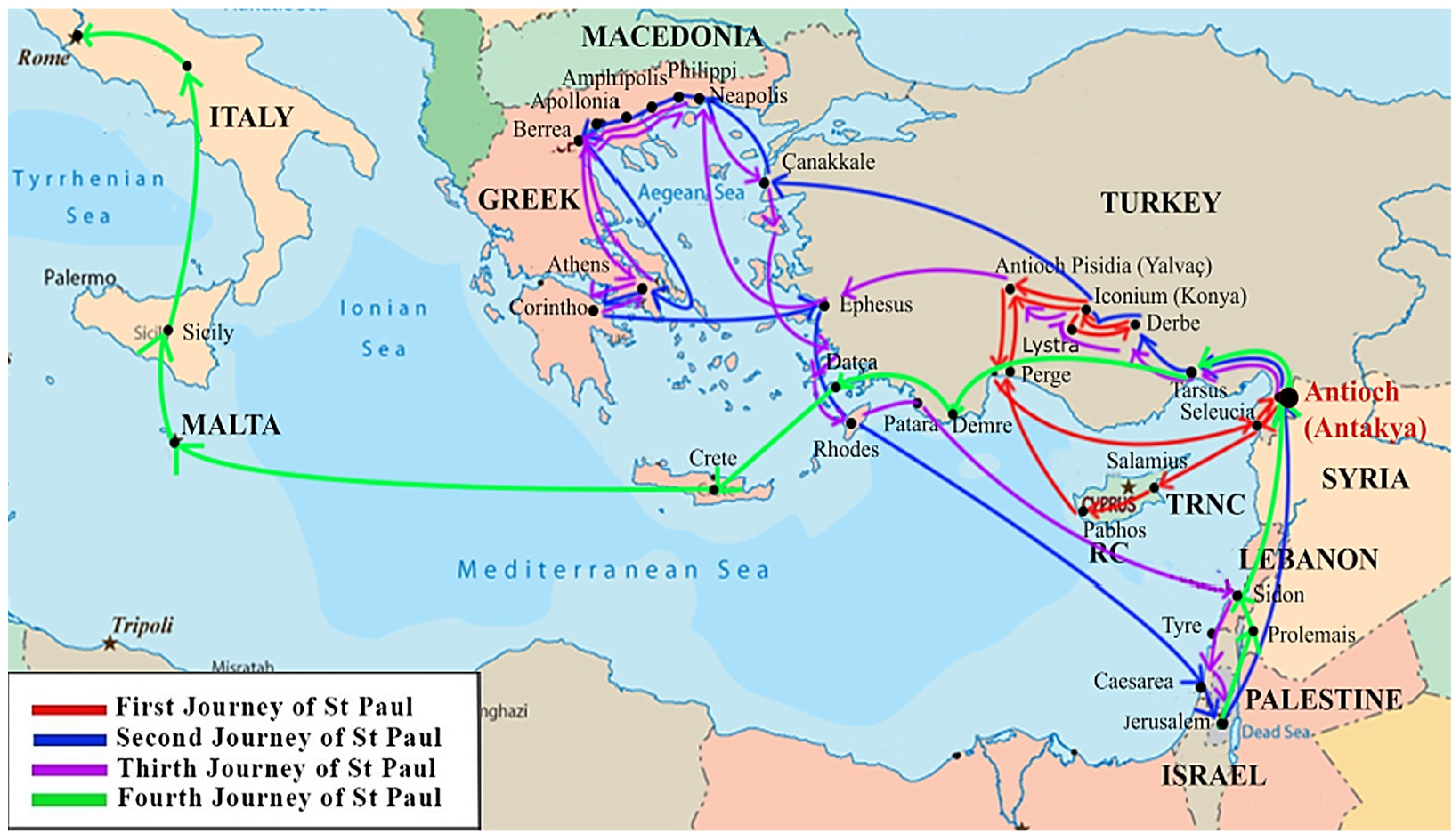

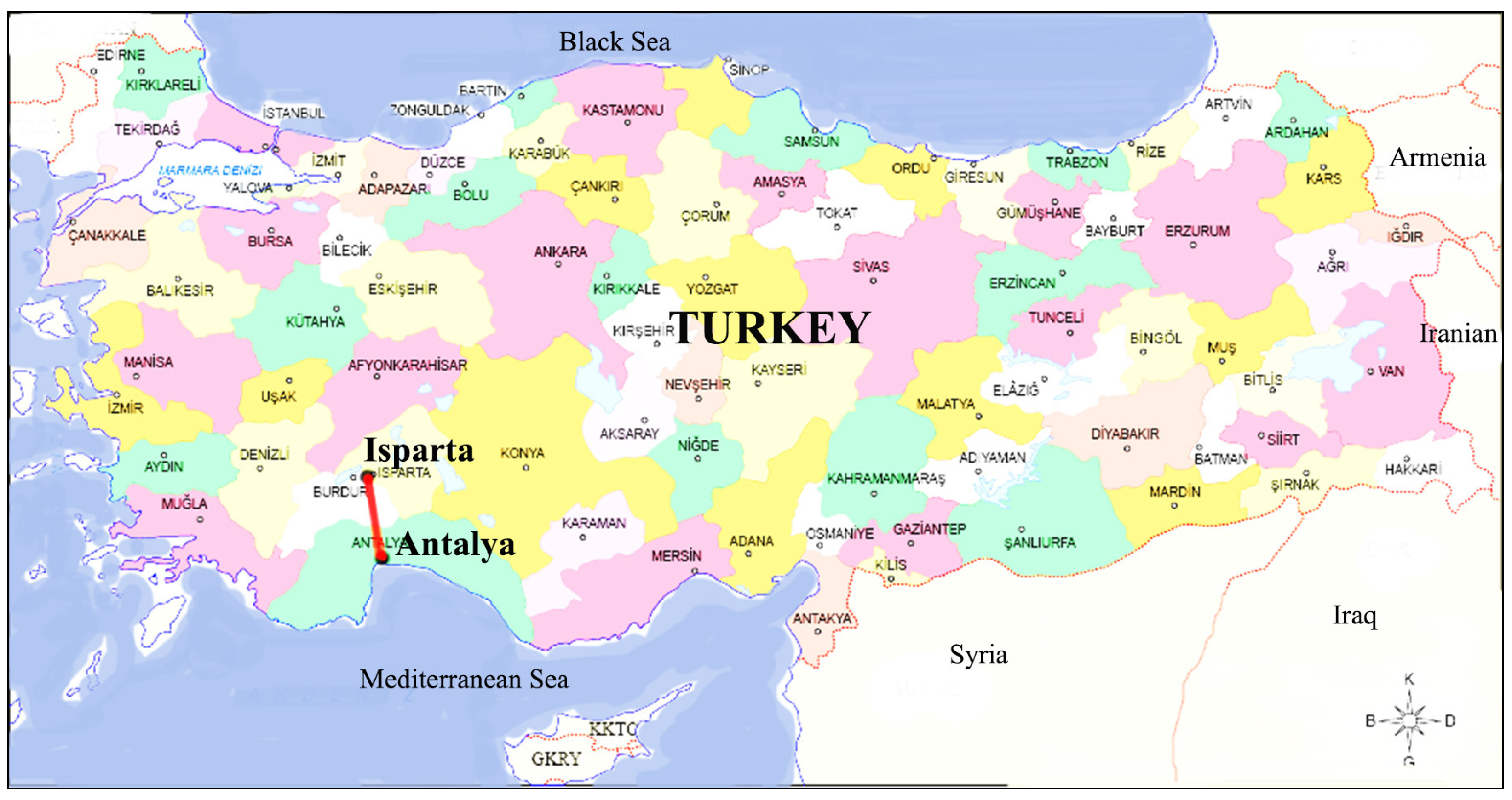
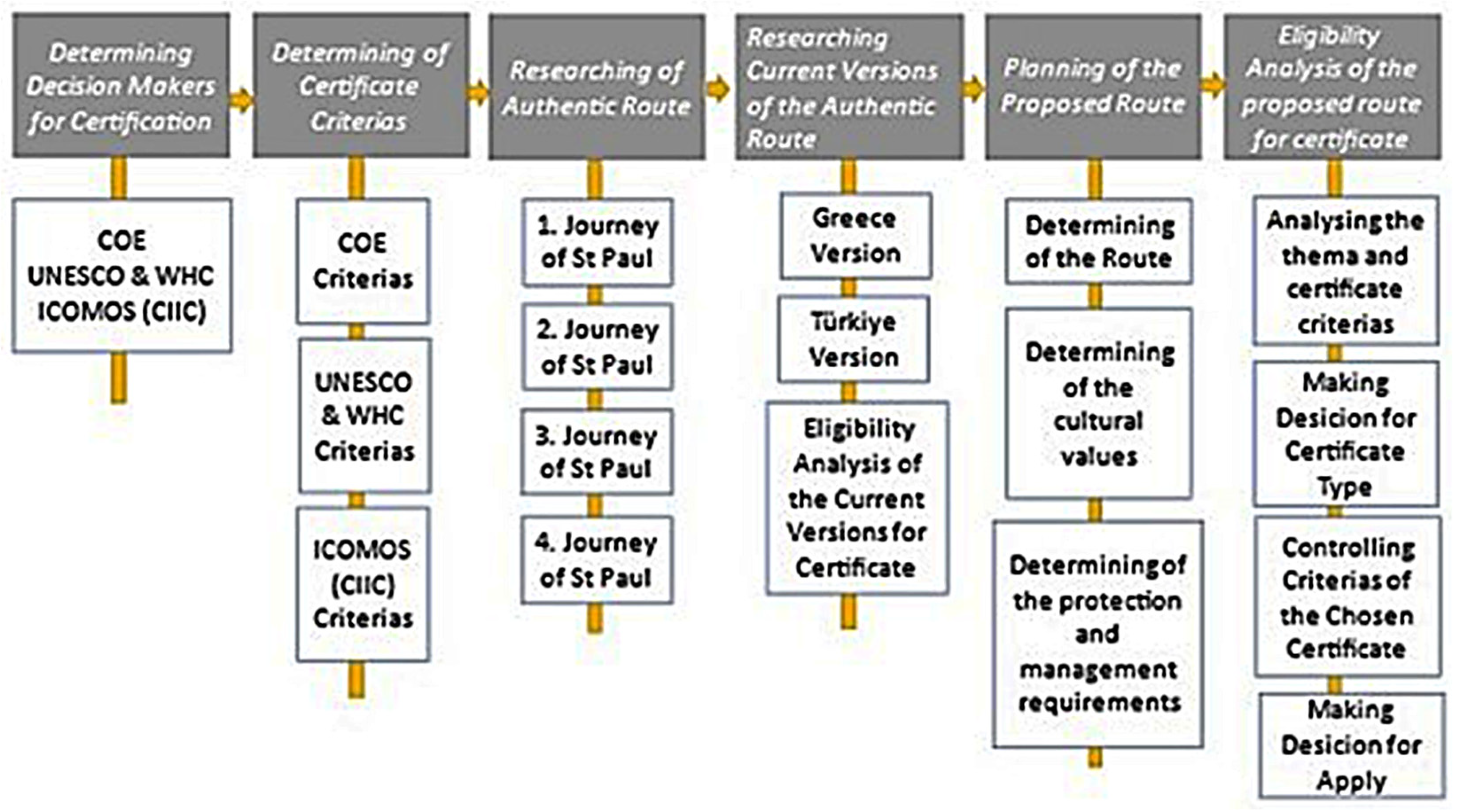
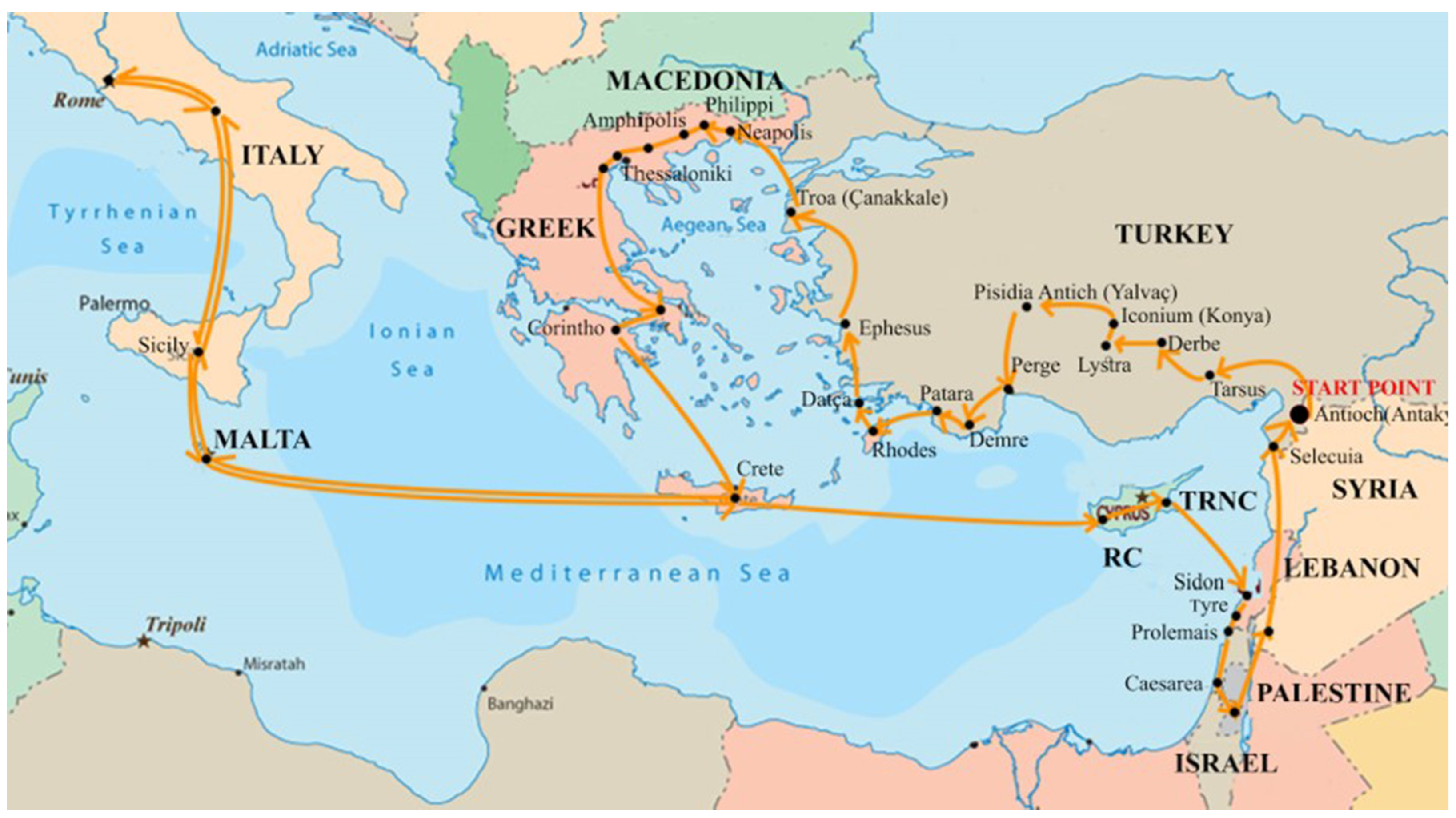
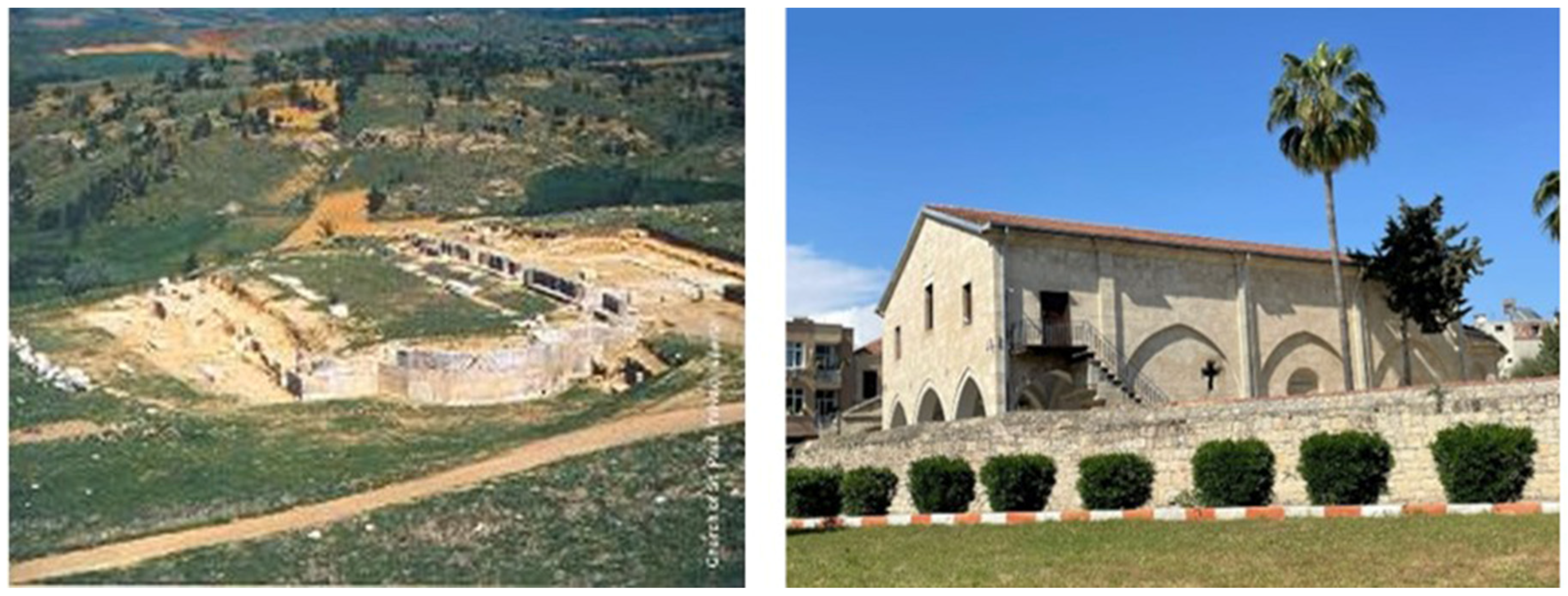
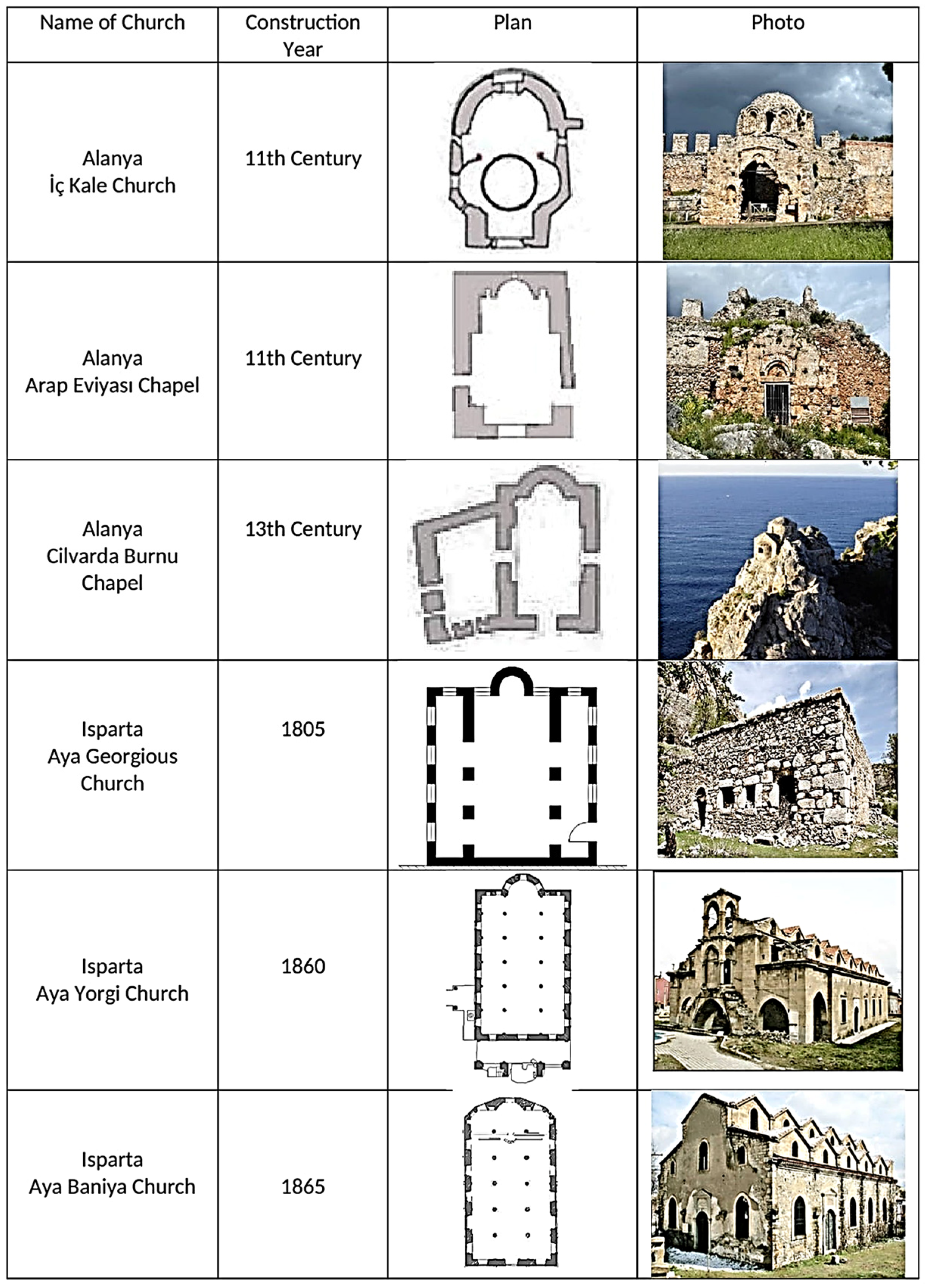
| Cultural Routes Works of COE | |
| Date | Event |
| 1964 | European Union: Expert Group start to discuss cultural routes. |
| 1984 | Invite member states for “Cultural Routes of the Council of Europe Programme” |
| 1990 | Establishment of “European Institute of Cultural Routes-EICR” |
| 1993 | First cultural route was announced as “The Santiago de Compostela Pilgrim Route” |
| 2002 | Creation of “A Common Heritage: Cultural Routes and Landscaping” web portal. |
| 2010 | The Enlarged Partial Agreement on cultural routes (EPA) established |
| 2012 | Published “The Colmar Declaration” |
| 2012 | Established “Crossroads of Europe” which has established cooperation with tourism companies, authorities, and other relevant stakeholders. |
| Cultural Routes Works of UNESCO, WHC and ICOMOS and CIIC Partnership | |
| 1994 | UNESCO and ICOMOS announce “Part of Our Cultural Heritage: Cultural Routes” |
| 1998 | ICOMOS establish the “The International Committee of Cultural Routes (CIIC)” |
| 2005 | UNESCO and WHC announce cultural routes as a part of World Heritage List |
| 2008 | ICOMOS publish “Charter on Cultural Routes” |
| COE Criteria (COE 2013) |
|
|
|
|
|
|
| UNESCO and WHC Criteria (UNESCO and WHC 2021) |
|
|
|
|
|
|
|
|
|
|
|
|
|
|
|
|
|
|
|
| ICOMOS and CIIC Criteria (ICOMOS 2008) |
|
|
|
|
|
|
|
|
|
| COE Routes (COE-CR 2023) | ||
| Date | Cultural Routes | |
| 1987 | Santiago De Compostela Pilgrim Routes | Religious Route |
| 1991 | The Hansa | |
| 1993 | Viking Route | |
| 1994 | Via Francigena | Religious Route |
| 1997 | Routes of El Legado Andalusí | Religious Route |
| 2003 | Phoenicians’ Route, Iron Route in the Pyrenees | |
| 2004 | European Mozart Ways | |
| 2004 | European Route of Jewish Heritage | Religious Route |
| 2005 | Saint Martin of Tours Route | Religious Route |
| 2007 | Transromanica—The Romanesque Routes of European Heritage | |
| 2009 | Iter Vitis Route | |
| 2010 | European Route of Cistercian Abbeys | Religious Route |
| 2010 | European Cemeteries Route | Religious Route |
| 2010 | Prehistoric Rock Art Trails, European Route of Historic Thermal Towns | |
| 2010 | Route of Saint Olav Ways | Religious Route |
| 2012 | European Route of Ceramics | |
| 2013 | European Route of Megalithic Culture, Huguenot and Waldensian Trail | |
| 2014 | Atrium—Architecture of Totalitarian Regimes of the 20th Century In Europe’s Urban Memory | |
| 2014 | Réseau Art Nouveau Network, Via Habsburg | |
| 2015 | Roman Emperors and Danube Wine Route, European Routes of Emperor Charles V, Destination Napoleon, In the Footsteps of Robert Louis Stevenson | |
| 2016 | Fortified Towns of the Grande Region | |
| 2018 | Impressionisms Routes, Via Charlemagne | |
| 2019 | European Route of Industrial Heritage, Iron Curtain Trail, Le Corbusier Destinations, Liberation Route Europe | |
| 2019 | Routes of Reformation | Religious Route |
| 2020 | European Route of Historic Gardens | |
| 2020 | Via Romea Germanica | Religious Route |
| 2021 | Aeneas Route, Alvar Aalto Route—20th Century Architecture and Design | |
| 2021 | Cyril and Methodius Route | Religious Route |
| 2021 | European Route d’Artagnan, Iron Age Danube Route | |
| 2022 | Historic Cafés Route, European Fairy Tale Route, Women Writers Route | |
| UNESCO and WHC Cultural Routes (UNESCO and WHC 2023) | ||
| 1993 | Routes of Santiago de Compostela: Camino Francés and Routes of Northern Spain | Religious Route |
| 1998 | Routes of Santiago de Compostela in France | Religious Route |
| 2004 | Sacred Sites and Pilgrimage Routes in the Kii Mountain Range | Religious Route |
| 2005 | Incense Route—Desert Cities in the Negev | |
| 2012 | Birthplace of Jesus: Church of the Nativity and the Pilgrimage Route, Bethlehem | Religious Route |
| 2014 | Silk Roads: the Routes Network of Chang’an–Tianshan Corridor | |
| 2014 | Qhapaq Ñan, Andean Road System | |
| ICOMOS and CIIC Cultural Routes (ICOMOS and CIIC 2023) | ||
| 2005 | Route of the Incense in the Negev | |
| 2010 | Camino Real de Tierra Adentro | |
| 2014 | The Silk Road | |
| 2014 | Qhapaq Ñan or Path of the Lord | |
| 2015 | Caminos de Santiago de Compostela: French Camino and Caminos del Norte de Spain | Religious Route |
Disclaimer/Publisher’s Note: The statements, opinions and data contained in all publications are solely those of the individual author(s) and contributor(s) and not of MDPI and/or the editor(s). MDPI and/or the editor(s) disclaim responsibility for any injury to people or property resulting from any ideas, methods, instructions or products referred to in the content. |
© 2023 by the author. Licensee MDPI, Basel, Switzerland. This article is an open access article distributed under the terms and conditions of the Creative Commons Attribution (CC BY) license (https://creativecommons.org/licenses/by/4.0/).
Share and Cite
Çelebi Karakök, M.E. Determining the Characteristics of Faith-Themed Routes in Order to Receive an International Certificate: Studies on St. Paul’s Travels. Religions 2023, 14, 1097. https://doi.org/10.3390/rel14091097
Çelebi Karakök ME. Determining the Characteristics of Faith-Themed Routes in Order to Receive an International Certificate: Studies on St. Paul’s Travels. Religions. 2023; 14(9):1097. https://doi.org/10.3390/rel14091097
Chicago/Turabian StyleÇelebi Karakök, Meryem Elif. 2023. "Determining the Characteristics of Faith-Themed Routes in Order to Receive an International Certificate: Studies on St. Paul’s Travels" Religions 14, no. 9: 1097. https://doi.org/10.3390/rel14091097
APA StyleÇelebi Karakök, M. E. (2023). Determining the Characteristics of Faith-Themed Routes in Order to Receive an International Certificate: Studies on St. Paul’s Travels. Religions, 14(9), 1097. https://doi.org/10.3390/rel14091097







